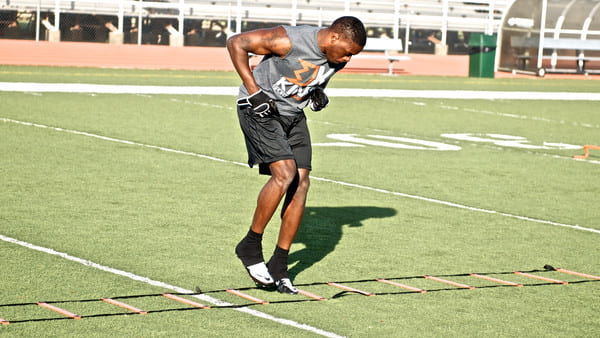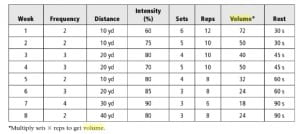
Sport specific agility drills with two clear progressions.
What is Agility?
‘Agility is the ability to move and change direction and position of the body quickly and effectively while under control. It requires quick reflexes, coordination, balance, speed, and correct response to the changing situation’. Quinn (2016).
Within sport, in certain circumstances the ability to change direction is very important in terms of speed, balance which will have a knock on effect of future decisions. However sports such as, sprinting and long jump normally require little change of direction and are often known as linear events. Yes it is easier to run or jump in a straight line rather than have to change direction but it does consist of speed, balance and coordination. Whilst it may not look it, these events are performed with one foot in contact with the ground at a time (unilateral). This is where strength, coordination and balance differences between either side of the body can have a great effect on athletic performance. Therefore, it is important to train bi-laterally and uni-laterally.
This video represents an example of building in muscle memory by repeating the movements which are involved in the full technique. The more we practice the technique correctly, the more likely we are to perform it in a competition environment.
Target Mechanism for High knee drill
Foot – Contact with ground balls of the feet, Minimal contact with the ground, Straight line direction, Feet in line with knee and hip alignment during the Claw back movement.
Leg movement – Drive through hips to enhance knee lift (hip level or higher), Knee flexion into extension, Fast rapid and backwards translation.
Posture – Athletic position is maintained throughout, Head is in line with body, head and eyes are focused to the front not on the ground or to either side.
Arm action: Short, rapid arm action in the sagittal plane.
(Jeffreys, 2006).
Speed and Agility Training Progression applicable to this video
1] Technical drills: Initiation and actualisation movements in a closed skill environment.
↓
Cognitive stage; introduce, demonstrate and explain
2) Pattern running: Two or more technical drills sequenced in a sport specific manner
↓
Motor stage; build upon technical proficiency through practice and error detection.
Volume load
To enhance speed and agility, a mesocycle approach can be adopted to allow clear progression and monitoring. Within a linear periodization program, a S&C coach will alter volume and intensity to produce a linear periodized program throughout each phase (depending on stage of the athlete). This type of periodization, decreases volume whilst increasing intensity (Graham, 2002). This will prevent the risk of overtraining for the athlete and will encourage peak performance at the time of competition.
The table below will show an example of how manipulating frequency, volume intensity and rest to employ a varied speed and agility session every week. Take note: exercises employed must be generic if the athlete is in general preparation phase of the pre-season whilst sport specific agility drills should be performed when entering the later stages of the pre season (Sport specific preparation phase).
Linear periodization Agility Program for an Advanced athletes.
Brown & Ferrigno (2014)
References
Brown, L. and Ferringno, V. (2014) Training for Speed, Agility, and Quickness: 3G. (3rd. ed) Human Kinetics: USA.
Graham, J. (2002) Periodization Research and an Example Application. Journal of Strength and Conditioning. Vol. 24, No. 6: 62-70.
Jeffreys, I. (2006) Motor Learning—Applications for Agility, Part 1, Journal of Strength & Conditioning, Vol. 28, No. 5: 72-76
Quinn, E. (2016) Agility. [Online] Available from: http://sportsmedicine.about.com/od/glossary/g/Agility_def.htm [accessed 09 March 2016].
